Step4: Creating a Dirt Road
|
| |
After the basic mountain texture was done, I wanted to place a house on the hill side and create a dirt road that starts at the house and fades away into the valley. To make a road, I added a new road layer with the limit map.
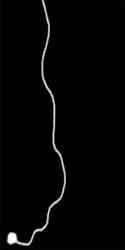 |
=> |
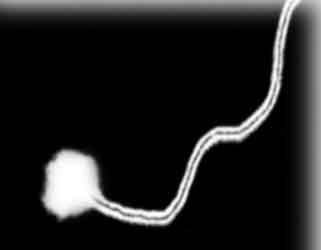 |
1. Limit map |
|
2. Zoom-in on the limit map |
The white circle was the place where a house was placed and 2 long white lines formed the dirt road.
I also used the same image for road layer's bump map (except inverted) to give some depth to the road. Of course, before the image could be used, I had to apply UVW mapping to the terrain.

Dirt road created with a limit map
|
Step5: Placing objects (using Viewport texture / Focused Area texture) |
| |
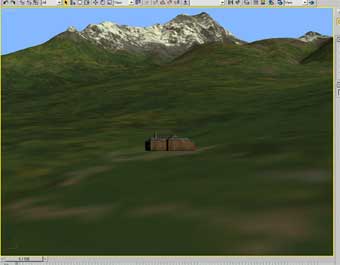 |
To place the house in the previous picture, I used 'GroundWiz Viewport Texture' feature. By pressing the 'Update' button in the Preview Panel of GroundWiz map, a terrain texture was created that was shown in the viewport.
(Picuture on the left: Viewport texture covers the whole terrain.) |
 |
In this case the whole terrain was huge so texture resolution around the house was too small to be useful when placing objects. For that reason, another option was added to the Preview Panel: 'Focused Area' texture. This way it is possible to create a viewport texture for a smaller area and really get all the texture resolution where needed.
To learn about how to set up and use Focused Area viewport texture, please read: 'Focus Area Obj' section in the reference guide.
(Picture on the left: Focused area viewport texture)
|
|
Step6: Planting Trees and Rocks |
| |
After having created a descent terrain map, it was time to plant objects with GroundWiz Planter. I used two pine trees and two types of rocks to create a forest. For each pine tree, I used three LOD objects.
In this case 2 GroundWiz Planters were used: one to hold pine trees and the other one to hold rocks. There was really no need to have 2 planters, except that it was a bit easier to have different settings for planting.
To achieve more varied and random look, 'Plant Transformations' panel offers numerous options on how to position, scale and rotate objects. For transformation settings for trees and rocks, check GroundWiz Manual.
With 'Do self collision' option on, I planted trees first and then adjusted parameters for rocks to make some of them sink into the ground more than others before planting them.
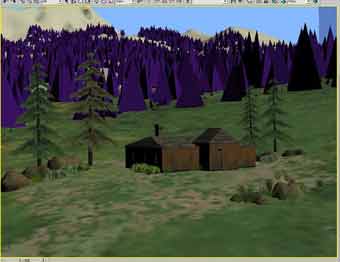 |
To plant objects:
- First I used 'Mass Planting' tool to quickly place objects all around the scene. Pressing 'Plant Now' starts the planting process that depending on the settings and the area size, can take quite some time.
- Secondly 'Detailed Planting' was used to clean up forest around the house. 'Brush Planting' proved to be a very handy tool in this case.
(Picture on the left: Planted objects displayed in Proxy mode for better redraw speed)
|
|
Step7: Planting Grass |
| |
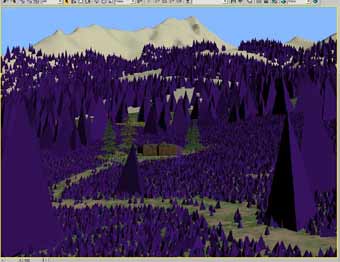 |
I added a few kinds of grass to the list of Planted Objects. Since grass is small and not going to be seen from far, 'LOD visibility' value was set to be quite big, which made grass disappear sooner.
To avoid planting grass on the dirt road, 'GroundWiz Layer Limits' option was used with 'Plants' layer in the list. House was added as a collision object to the list of 'Max Objects' to avoid colliding with and using 'Max Object Influence' parameters, I made grass shorter and scarcer, approaching the house. Check GroundWiz Manual for more detailed settings.
(Picture on the left: Grass was planted around the house and road -displayed in Proxy mode)
|
|
Step8: Rendering the Scene with mental ray |
| |
When rendering with MR (mental ray) and GroundWiz Terrain Map is used as a bump map, in that case you need to use 'GroundWiz Output' to 'hold' GroundWiz Terrain Map. Please read more about it in the 'GroundWiz Output' section.
If the scene is big (many millions of triangles), it is important to set up MR renderer correctly (Large BSP and other settings). Please refer to 'mental ray Shaders' section.
|
And here is the end result...
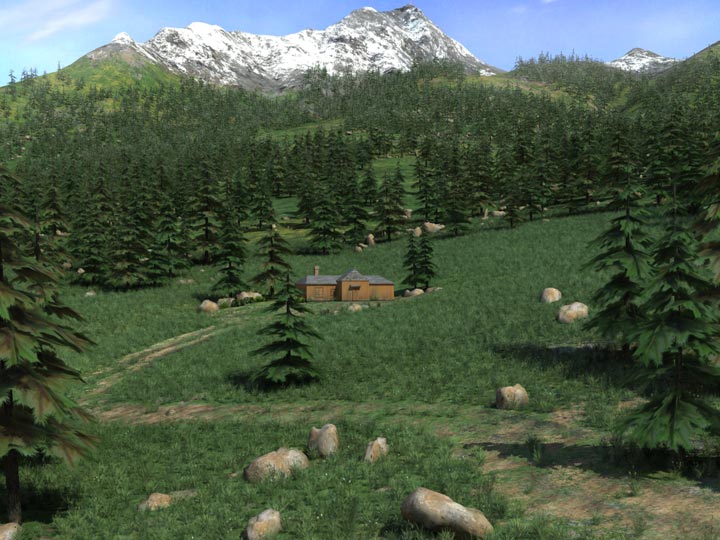
|
<<previous 1 2
|
Check other tutorials |